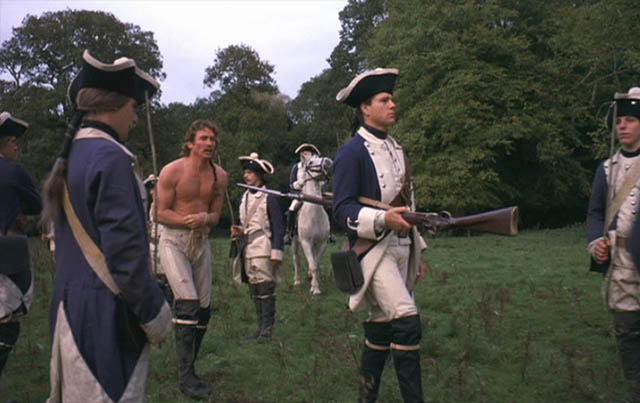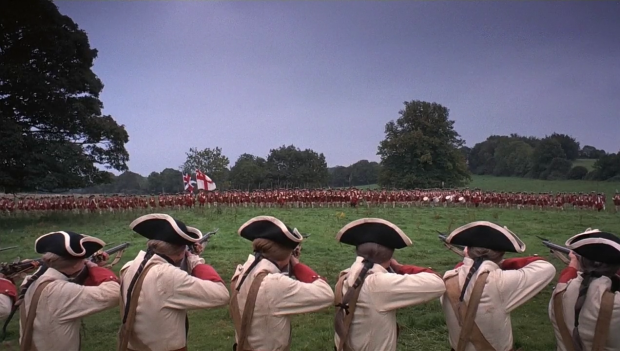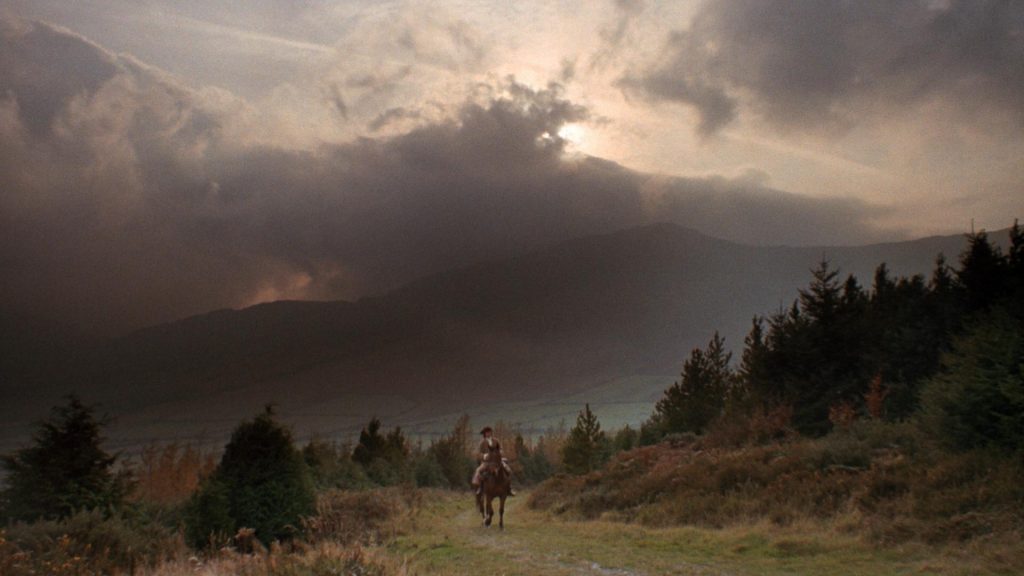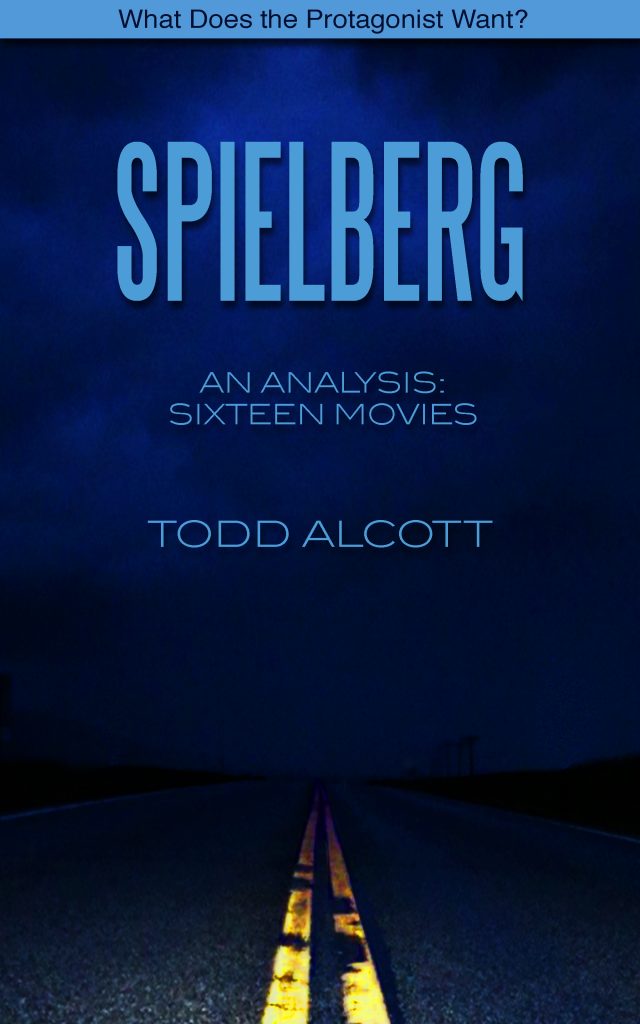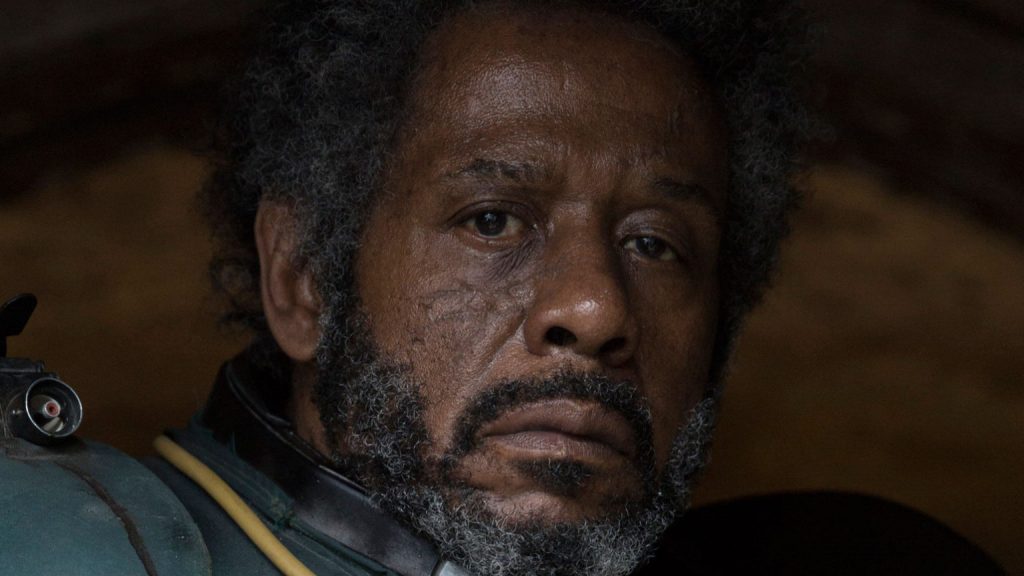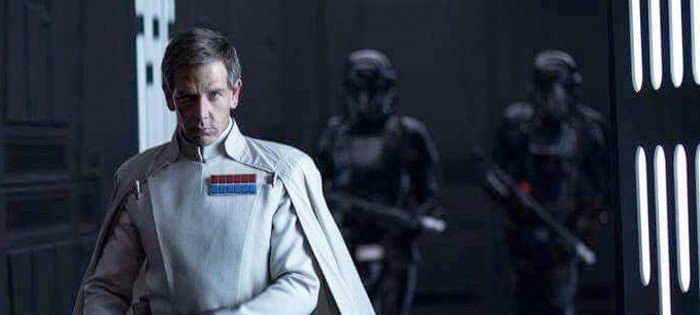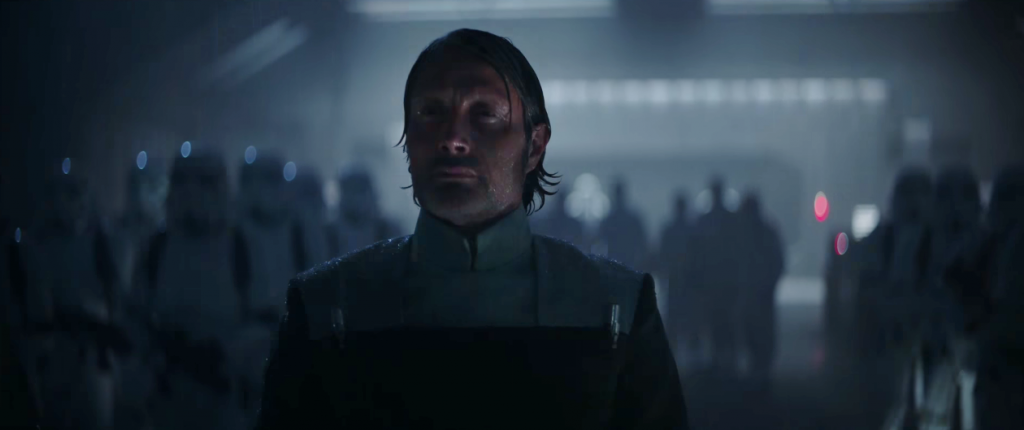Kubrick: Barry Lyndon part 4
SCENE 40. So, Barry has been arrested as an impostor and is now re-born as a Prussian footsoldier. And, although it is Barry who is re-born, it is an unnamed soldier who is spanked as Barry leads him through “the gauntlet.” The narrator informs us that Barry has definitely fallen from the frying pan to the fire, that the rules of being a Prussian footsoldier are quite a bit more unfair than those of the British. The primary factoid that the narrator imparts during the gauntlet scene is that the gauntlet is a common punishment and “every officer had the right to inflict it.”
So, again, our three themes are present. Violence, here, is the first, most noticeable one, as the gauntlet of whipping goes on. Social mobility is present both “in the cut” as Barry goes from being a British officer to a Prussian footsoldier, and in his relative status to the poor guy being whipped, and in the narration as the narrator tells us that officers have “the right” to have violence inflicted on those of lower social standing for whatever reason they choose, just as kings have “the right” to push their armies across the globe to suffer and die for the king’s pleasure. Love is present in the form of Capt Potzdorf, who is on his horse (reflecting his elevated social status) in the background, overseeing the beating (beatings must be properly administered, otherwise how do offenders learn?). When I say that love is present in the form of Potzdorf, I mean that it is present in its inverse, that Potzdorf is in the narrative as an inversion of the beloved Capt Grogan, who was Barry’s father figure in the British army. Which is not to say that Potzdorf hates Barry, necessarily, only that his relationship to Barry is designed to reflect Grogan’s unconditional love.
(There is, after all, a whole other plotline present in Barry Lyndon regarding Barry’s search for a man to replace his dead father, or, rather, the manner in which the universe presents father figures to Barry for him to choose until he’s ready to become a father himself. First Grogan, now Potzdorf, and, soon enough, the Chevalier du Balibari.)
Kubrick: Barry Lyndon part 3
SCENE 25. Following some mysterious stock footage of a ship while the narrator explains the Barry is sailing to Germany to fight in the Seven Years War, midway through Act II of Barry Lyndon, we get what passes, in this peculiar cinematic narrative, for an action set piece. Barry’s regiment faces down some French troops, which the narrator describes as “a tiny skirmish, unrecorded by history.” To a present-day viewer — or to a viewer in 1975 — the sequence is mind-boggling in its cold violence. The British troops, true to the engagement strategies of the day, wear red against the greenery of the field, and march in a wide, straight line toward their attackers, who are similarly arrayed. The French soldiers mow down row after row of British troops with volleys from their flintlock muskets, as the British implacably approach.
I’m not a military historian, so the logic of this attack strategy in its context is lost to me, as it would be to any viewer in 1975, with the Vietnam war freshly over and World War II within living memory. But even the battle sequence in Kubrick’s Spartacus presents an enemy less suicidal than the British here. I’m sure strategy has been worked out on paper by generals somewhere, so many men per unit, so much ground covered in x amount of time, so many guns, so many bayonets, etc. But this is the first time in the movie that violence, on a massive scale, is recorded in closeup, and the effect is, like any classic Kubrick sequence, is both sweeping in its scale and chilling in its dispassion. You can compare the British attack on the French in Barry Lyndon to the murder of Frank Poole in 2oo1 or to the end of the world set to a Vera Lynn song in Dr. Strangelove.
Kubrick: Barry Lyndon part 2
Act I of Barry Lyndon takes about a half hour and has a total of thirteen scenes. Act II takes a little over a half-hour and twenty-six scenes — twice as many. Act I takes Barry from rash teenage hijinks to being on the run from the law, Act II takes him out of the fire, puts him, briefly, into a frying pan, and then back into a bigger fire, then puts him, briefly, into a comfy seat next to the fire, before throwing him headlong back into an even bigger fire.
SCENE 14: Barry sets out into the world. A tiny figure in a vast landscape, he heads toward Dublin and, he hopes adventure. The narrator informs us that Barry immediately forgets about Nora, for whom he threw his entire life into a cocked tricorn hat. While the circumstances of his ejection from his home may have been violent and stupid, he now feels pretty good about himself. He has 20 pounds in his pocket and is out to see the world, a young man with a toehold on social mobility.
Kubrick: Barry Lyndon part 1
At the request of absolutely no one, but on the occasion of Criterion’s release of their edition of Kubrick’s 1975 costume drama, I’ve decided to sit down and try to tackle this most perplexing and misunderstood of Kubrick’s movies.
WHAT DOES THE PROTAGONIST WANT? Redmond Barry, as he is known in the first half of the movie, is torn between two conflicting desires. At the one end is “love,” which he desires strongly, and at the other end is “social mobility,” which, as life inflicts itself upon him, he gradually comes to desire more and more.
Kubrick lets us know, before the movie even starts, that his subject here is social mobility. A title card announces that the first half of the movie will tell us how Redmond Barry, local nobody, gradually comes to be known as fabulously rich guy Barry Lyndon. As the narrative unfolds, we see how the conflicting impulses of love and social mobility come to define Barry’s journey, and how the ever-present threat of violence serves as a kind of lubricant for both desires.
Spielberg
My new volume of analysis, the double-sized, sixteen-movie volume on the films of Steven Spielberg, is now available for humans with eyeballs to read at Amazon.
Amazing at it sounds, Spielberg remains one of the most misunderstood, and underrated, directors of our time. If you’ve ever dismissed Spielberg, or thought “What’s the big deal?” or hated him for his whatever you hate him for, this volume will shed new light on his work. And if you’ve always liked his work but didn’t know why, this book will also shed new light on his work. And if you’ve always loved his work, this book will still shed new light on his work. Guaranteed.
Coen Bros: Five Films
Now available at Amazon, for your reading pleasure, my analysis of No Country For Old Men, A Serious Man, True Grit, Inside Llewyn Davis and Hail, Caesar! Certainly five of the greatest movies released in the past decade. Endlessly watchable, endlessly rewarding of examination. Analytical readings of analytical screenplays from analytical writers. I especially recommend this volume for people who don’t “get” A Serious Man, Inside Llewyn Davis and Hail, Caesar!.
Batman on the Big Screen
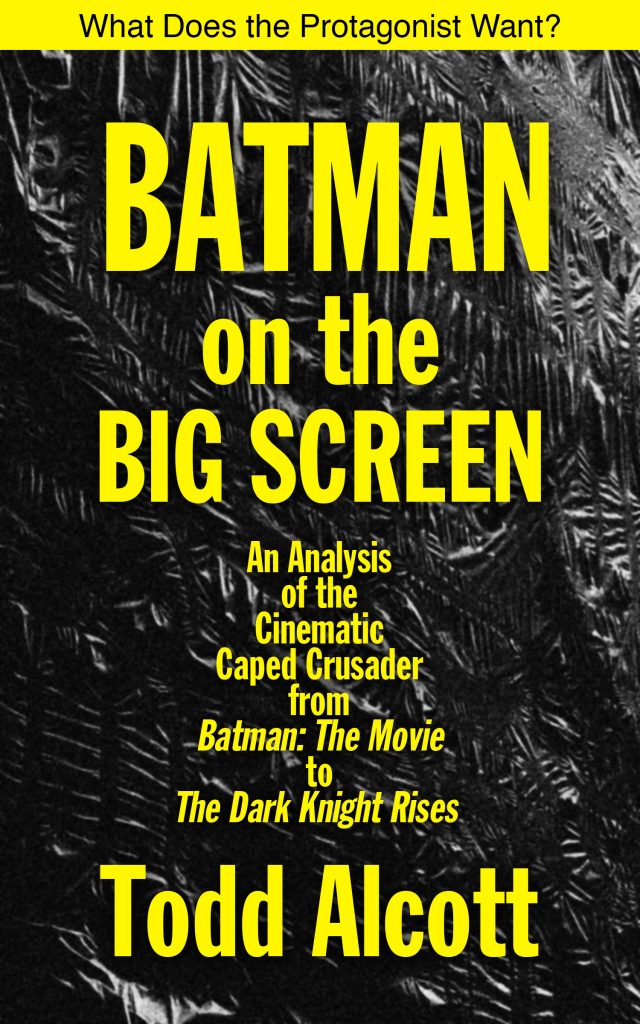
Batman on the Big Screen, a volume collecting everything I’ve written about the Caped Crusader, is now for sale at Amazon. It’s the first in what will be a long line of volumes under the What Does The Protagonist Want? banner. Having just finished editing it, I can tell you, it’s still highly addictive reading!
some thoughts on Rogue One: The Gang
The question that Rogue One poses is “What does it mean to rebel?” Why rebel against authority? Should one rebel against all authority? What does rebellion do to one’s soul? What does conformity do to one’s soul? Why rebel when rebellion will lead to the deaths of millions, and maybe the death of you? Star Wars movies, up ’til now, have always explored the question of Empire vs Rebellion in stark black-and-white terms, but Rogue One dices up those terms, folds them over and then dices them up again before arriving at a conclusion.
some thoughts on Rogue One: Director Krennic
Before we discuss Director Krennic, let’s take a look back at the previous “bad guys” from the Star Wars universe:
First and foremost there is Darth Vader. Darth Vader starts off as “evil” in Episode IV, develops into “evil, but subservient to a greater evil” in Episode V, and, finally, “evil, but conflicted, and eventually redeemed” in Episode VI. Vader’s Terminator-like consistency was part of his appeal, it was what made him terrifying. He wore a mask, you couldn’t know what he was thinking, he destroyed anything that got in his way.
Then there is Emperor Palpatine. Emperor Palpatine is an uncomplicated climber, a man whose pursuit of power didn’t corrupt him at all, because he was evil to begin with. He started out a villainous creep and ended up as, apparently, all Sith Lords end up: killed by his own apprentice.
Then there are garden-variety bad guys like Grand Moff Tarkin, Jabba the Hutt, General Grievous and Nute Gunray, who range from sniveling pawns to grotesque monsters.
What all of them have in common is “they are bad.” In story meetings, when the producer asks “What is the antagonist’s motive?” the poor screenwriter says “He does bad things because he is bad.” That, of course, is how you know you’re writing a melodrama.
(The word “melodrama,” for non-theater-nerds, comes from the theater of early America, where people of many different linguistic backgrounds would all go to the theater to enjoy a play. Because not everyone spoke the language being used on stage, the band in the pit would cue the audience as to how to feel about different characters. A “sweet” character would be given a sweet melody, a “sinister” character would be given a sinister melody, a hero would be given a heroic melody, and so forth. Hence, “melodrama,” a dramatic form where the audience is heavily cued as to the “good and bad” of the narrative. John Williams’s music for the earlier movies used all these tricks to good effect: Luke got a yearning theme, Leia got a gentle theme, Darth Vader got an imperial march.)
The problem with this approach, of course, is that no bad guy ever thinks of himself as “the bad guy.” As Jean Renoir said, “everyone has their reasons.”
Things have improved with the re-launch of the brand and Episode VII. Kylo Ren is a genuine freak, a perverse, warped individual who is compelled to do bad things even when he doesn’t want to, who wears a mask when he doesn’t need to, who reacts with fear and confusion when his worldview is challenged.
And now we have Director Krennic, the most finely-drawn, complex villain we’ve seen yet.
some thoughts on Rogue One: Galen Erso
Of all the characters in Rogue One, Galen Erso has the most complicated motivations, which I will discuss inside.
